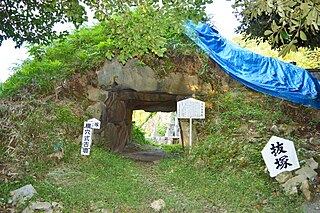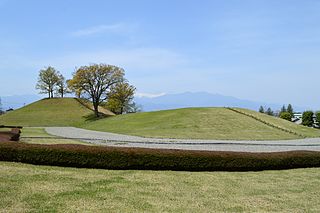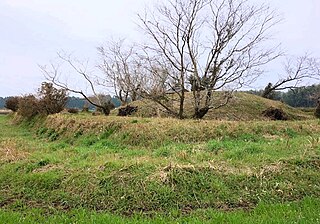
The Takayasu Senzuka Kofun Cluster is a group of Kofun period burial mounds, distributed around the foot of Mount Takayasu at elevations of 50 to 300 meters, in the city of Yao, Osaka Prefecture. in the Kansai region of Japan. The tumulus group was designated a National Historic Site of Japan in 2015.

The Ayamezuka Kofun (菖蒲塚古墳) is a keyhole-shaped kofun burial mound located in the Takenomachi neighborhood of Nishikan-ku, Niigata in the Hokuriku region of Japan. The tumulus was designated a National Historic Site of Japan in 1938.

Otozuka Kofun - Danjirimaki Kofun is a pair of kofun burial mounds located in the Izumi neighborhood of the city of Toki, Gifu in the Chūbu region of Japan. The two tumuli were collectively designated a National Historic Site of Japan in 1938.

Shidami Kofun group is a cluster of seven Kofun period burial mounds, located in what is now part of Moriyama-ku, Nagoya, Aichi Prefecture in the Tōkai region of Japan. The Shiratorizuka Kofun was designated a National Historic Site of Japan in 1972 and the remaining six were added to the designation in 2014..

The Hodota Kofun Cluster (保渡田古墳群) is a group of three Kofun period burial mounds located in what is now the city of Takasaki, Gunma Prefecture in the northern Kantō region of Japan. It was designated a National Historic Site of Japan in 1985.

The Kai Chōshizuka Kofun (甲斐銚子塚古墳) is a kofun burial mound located in the Shimosone neighborhood of the city of Kōfu, Yamanashi in the Chūbu region of Japan. Together with the adjacent Maruyamazuka Kofun (丸山塚古墳) it was designated as a National Historic Site of Japan in 1930. It is one of the largest keyhole-shaped tumuli in eastern Japan and has a total length of 169 meters. The tumuli are located a three minute walk from the "Kenritsukōkohakubutsukan" bus stop on the Yamanashi Kōtsu Kankō Bus from Kōfu Station.

Funakiyama Kofun group is a cluster of Kofun period burial mounds located the city of Motosu, Gifu Prefecture in the Chūbu region of Japan. It was designated a National Historic Site of Japan in 2018.

Ryūgakuji kofun cluster is a group of Kofun period burial mounds located in what is now the Ryukakuji neighborhood of the town of Sakae and extending into the city of Narita, Chiba Prefecture in the Kantō region of Japan. The site was designated a National Historic Site of Japan in 1941, with the area extended in 2009. Containing 114 tumuli, it is the largest cluster of kofun in the Kantō region. The National Historic Site designation also singles out Kofun No. 105, which is named the Iwaya kofun (岩屋古墳).

The Futagozuka Kofun (二子塚古墳) is a Kofun period keyhole-shaped burial mound, located in the Yamaga neighborhood of the town of Taishi, Minamikawachi District, Osaka in the Kansai region of Japan. The tumulus was designated a National Historic Site of Japan in 1956, with the area under protection extended in 2019. It is the one of the Isonagadani Kofun Cluster (磯長谷古墳群), a group of 30 kofun, five of which have been designated as imperial tombs by the Imperial Household Agency.

The Tamaoka Kofun cluster (玉丘古墳群) is a group of seven kofun burial mounds located in the Shinya, Tamaoka and Tamano neighborhoods of the city of Kaisai, Hyōgo Prefecture, in the Kansai region of Japan. The Tamaoka Kofun was individually designated a National Historic Site in 1943, with the others added in 1978 and the area under protection expanded in 1997.

The Dannozukaana Kofun cluster (段の塚穴古墳群) is a pair of Kofun period burial mounds, located in the Mima neighborhood of the city of Mima, Tokushima on the island of Shikoku in Japan. It was designated a National Historic Site of Japan in 1942.

The Naruto Itano Kofun cluster is a group of nine kofun burial mounds located between the city of Naruto and Itano, Tokushima Prefecture, on the island of Shikoku, Japan. The tumuli were collectively designated a National Historic Site in 2016.

The Sanmyōji Kofun (三明寺古墳) is a Kofun period burial mound located in the Iwaojō neighborhood of the city of Kurayoshi, Tottori Prefecture in the San'in region of Japan. The tumulus was designated a National Historic Site of Japan in 1931. One of the burial mounds in the Mukaiyama Kofun Cluster.

The Ōya-Sada Kofun Cluster is a group of six kofun burial mounds located in the Kaminakatsui neighborhood of the city of Maniwa, Okayama Prefecture, in the San'yō region of Japan. The tumuli were collectively designated a National Historic Site in 2008. The tumuli area considered to be representative of large chieftain tombs of the late Kofun period of the Kingdom of Kibi.
The Ōbaniwatorizuka (大庭鶏塚古墳) is a Kofun period burial mound, located on the border of the Ōba-chō neighborhood of the city of Matsue, Shimane in the San'in region of Japan. The tumulus was designated a National Historic Site of Japan in 1924.

The Arashima Kofun cluster (荒島古墳群) is a group of Yayoi to Kofun period burial mounds located in the Aratori-cho and Kujira-cho neighborhood of the city of Yasugi, Shimane Prefecture in the San'in region of Japan. The tumulus group was designated a National Historic Site of Japan in 1936 with the area under protection expanded in 1999.

The Jōshinzuka Kofun (常心塚古墳) is a Kofun period burial mound located in the Kamisanzai-chō neighborhood of the city of Saito, Miyazaki Prefecture in Kyushu Japan. The tumulus was designated a National Historic Site of Japan in 1980.

Furumiya Kofun (古宮古墳) is an Asuka period burial mound, located in the Matsubara Dentarukuri Nikku neighborhood of the city of Ōita on the island of Kyushu, Japan. The tumulus was designated a National Historic Site of Japan in 1973.

The Yame Kofun cluster is a group of kofun burial mounds located in the Yame hills, across the towns of Yame, Hirokawa, Chikugo, Fukuoka, Japan. The Noriba Kofun was designated a National Historic Site in 1922, followed by the Iwatoyama, Ishijinyama, Zenzōzuka, and Kōgadani Kofun on an individual basis. These five separate National Historic Sites were merged into a single site in 1978, and the Maruyamazuka, Maruyama, and Chausuzuka Kofun were added to the protected area.

The Tsuyazaki Kofun Cluster (津屋崎古墳群) is a Kofun period burial mound, located in Fukutsu, Fukuoka, Fukuoka Prefecture Japan. The tumulus was designated a National Historic Site of Japan in 2000.

























